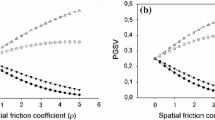Abstract
The Banks set (1(4):295–306, 1985) is one of the more important concepts in voting theory since it tells us about the sophisticated outcomes of standard amendment voting procedures commonly in use throughout the English speaking world (and elsewhere as well). While the properties of the Banks set for finite voting games have been extensively studied, little is known about how to find members of this set for majority rule spatial voting games involving possibly infinite agendas. We look at this question for two-dimensional games where voters have Euclidean preferences, and offer a variety of new results that delimit areas of the space that can be shown to lie within the Banks set, such as the Schattschneider set, the tri-median set, and the Banks line set—geometric constructs which we show to be nested within one another.
Similar content being viewed by others
References
Banks J: Sophisticated voting outcomes and agenda control. Soc Choice and Welf 1(4), 295–306 (1985)
Banks JS, Duggan J, Le Breton M: Bounds for mixed strategy equilibria and the spatial model of elections. J Econ Theory 103, 88–105 (2002)
Bianco WT, Jeliazkov I, Sened I: The limits of legislative actions: determining the set of enactable outcomes given legislators preferences. Polit Anal 12(3), 256–276 (2004)
Bianco WT, Lynch MS, Miller GJ, Sened I: A theory waiting to be discovered and used: a reanalysis of canonical experiments on majority-rule decision making. J Polit 68(4), 838–851 (2006)
Black D: The theory of committees and elections. Cambridge University Press, New York (1958)
Cox G: The uncovered set and the core. Am J Polit Sci 31(2), 408–422 (1987)
Farquharson R (1970) Theory of voting. Yale University Press, New Haven, Connecticut
Feld SL, Godfrey J, Grofman B. The Shapley–Owen value and the strength of small winsets: predicting central tendencies and degree of dispersion in the outcomes of majority rule decision-making. In Salles M et al (eds) Festschrift for Moshe Machover and Daniel Felsenthal (title tentative) (forthcoming)
Feld SL, Grofman B: The Borda count in N-dimensional issue space. Publ Choice 59, 167–176 (1988a)
Feld SL, Grofman B: Majority rule outcomes and the structure of debate in one-issue-at-a-time decision making. Publ Choice 59, 239–252 (1988b)
Feld SL, Grofman B: A theorem connecting shapley-own power scores and the radius of the yolk in two dimensions. Soc Choice Welf 7, 71–74 (1990)
Feld SL, Grofman B, Hartley R, Kilgour MO, Miller N: The uncovered set in spatial voting games. Theory Decis 23, 129–156 (1987)
Fishburn PC: Condorcet social choice functions. SIAM J Appl Math 33, 469–489 (1977)
Godfrey J (2005) Win—Set Computer Program
Godfrey J (2007) WINSET: a computer program for social choice
Godfrey J, Grofman B, Feld SL. Applications of Shapley–Owen values and the spatial copeland winner. Polit Anal (forthcoming)
Graham RL: An efficient algorithm for determining the convex hull of a finite planar set. Inf Proces Lett 1, 132–133 (1972)
Hartley R, Kilgour M: The geometry of the uncovered. Set Math Soc Sci 1, 175–183 (1987)
Jean-François L: Tournament solutions and majority voting (studies in econometric theory, vol 7). Springer, Berlin (1997)
Kramer G: Sophisticated voting over multidimensional spaces. J Math Sociol 2, 165–180 (1972)
McKelvey RD: Covering, dominance, and institution-free properties of social choice. Am J Polit Sci 30(2), 283–314 (1986)
Miller N: A new solution set for tournament and majority voting. Am J Polit Sci 24(1), 68–96 (1980)
Miller NR, Grofman B, Feld SL: The structure of the banks set. Publ Choice 66, 243–251 (1990)
Moser S: Scoring methods and banks stability: nature versus the agenda setter. Unpublished paper, Nuffield College, Oxford (2008)
Moulin H: Choosing from a tournament. Soc Choice Welf 3, 271–291 (1986)
Owen G, Shapley LS: Optimal location of candidates in ideological space. Int J Game Theory 18, 125–142 (1989)
Penn E: Alternative definitions of the uncovered set, and their implications. Soc Choice Welf 27(1), 83–87 (2006a)
Penn E: The banks set in infinite spaces. Soc Choice Welf 27(3), 531 (2006b)
Saari D: The geometry of majority rule. Springer, Berlin (1994)
Schattschneider EE: The semi-sovereeign people. Holt-Rinehart, New York (1968)
Schofield N: Democratic stability. In: Knight, J, Sened, I (eds) Explaining social institutions, University of Michigan Press, Ann Arbor (1995)
Shepsle KA, Weingast B: Structure-induced equilibrium and legislative choice. Publ Choice 37(3), 503–519 (1981)
Shepsle K, Weingast B: Uncovered sets and sophisticated voting outcomes with implications for agenda institutions. Am J Polit Sci 28, 49–74 (1984)
Straffin Jr PD: Topics in the theory of voting. Birkhauser, Boston (1980)
Wuffle A, Feld Scott L, Owen G, Grofman B: Finagle’s law and the Finagle point, a new solution concept for two–candidate competition in spatial voting games. Am J Polit Sci 33(2), 348–375 (1989)
Author information
Authors and Affiliations
Corresponding author
Rights and permissions
About this article
Cite this article
Feld, S.L., Godfrey, J. & Grofman, B. In quest of the banks set in spatial voting games. Soc Choice Welf 41, 43–71 (2013). https://doi.org/10.1007/s00355-012-0676-0
Received:
Accepted:
Published:
Issue Date:
DOI: https://doi.org/10.1007/s00355-012-0676-0




